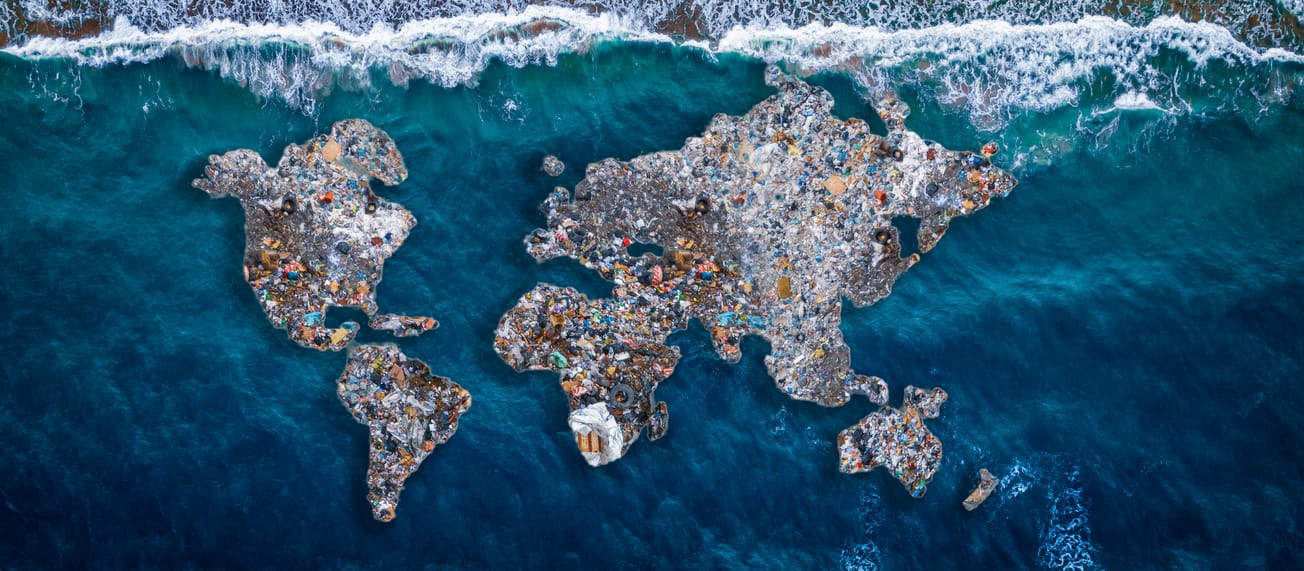Despite the 16th Conference of the Parties to the Convention on Biological Diversity (COP16) opening today, only 16% (32/196) of Parties have submitted National Biodiversity Strategies and Action Plans (NBSAPs) aligned with the Kunming-Montreal Global Biodiversity Framework to the Secretariat.
A groundbreaking decision from the International Tribunal on the Law of the Sea (ITLOS) could change the way States will include areas within and beyond national jurisdiction in their NBSAPs. But how does a law decision, based on the United Nations Convention on the Law of the Sea, influence a country’s climate and nature strategy? And what does this legal jargon actually mean for our oceans and climate efforts? Let's dive in.
The Kurt Grönfors Lecture is a recurring seminar series organised by the University of Gothenburg. The 2024 leture was titled 'The Ocean-Climate Nexus in International Law'.
Why this matters
The ocean is our planet's unsung climate hero. Since the mid-1990s, the ocean has been absorbing about 25% of the CO2 emitted into the atmosphere and the ocean continues to capture 90% of the excess heat generated by greenhouse gas emissions. If it weren't for the ocean's ability to absorb heat, Earth's average surface temperature would be ≈ 36 degrees Celsius hotter than it currently is, and most species, us included, wouldn't be able to thrive.
Climate change is just one of the triple planetary crises currently threatening Earth’s ocean while declining biodiversity and increasing pollution pose a suite of other problems. Around 1 million species are currently at risk of extinction, many within decades, and the live coral cover has halved since the 1870s (Global Assessment Report on Biodiversity and Ecosystem Services, IPBES).
The world's response
Recognising these threats, countries have united to develop several conventions to combat climate change, loss of biodiversity, desertification and now, more recently, plastic pollution.
But before all of these conventions, back in 1982, the United Nations Convention on the Law of the Sea (UNCLOS) – known as the “Constitution of the Ocean” – was adopted to bring a new regime of law and order in the world’s oceans.
Within the Law of the Sea Convention, Parties agreed to the establishment of the International Tribunal for the Law of the Sea (ITLOS) as a body to settle disputes between States’ Parties to the Convention regarding the interpretation or application of the Convention's provisions.
While the ocean’s importance is now recognised, the UNCLOS was created before we fully understood climate change and declining biodiversity. This new legal opinion from ITLOS helps bridge that gap.
The big question: are anthropogenic greenhouse gases considered "ocean pollution"?
In 2023, the Commission of Small Island States on Climate Change and International Law submitted a request for an advisory opinion to be made by ITLOS in relation to climate change. In response to this, the ITLOS had to answer a crucial question: do anthropogenic greenhouse gas emissions count as pollution of the marine environment?
Under UNCLOS (Article 1, paragraph 4), for a substance to be considered to cause “pollution in the marine environment”, the substance must:
- be a substance or energy;
- be introduced by humans directly or indirectly into the marine environment, including estuaries; and
- this introduction results or is likely to result in deleterious effects including harm to living resources and marine life, hazards to human health, hindrance to marine activities, including fishing and other legitimate uses of the sea, impairment of quality for use of sea water and reduction of amenities.
The ITLOS ruled that anthropogenic greenhouse gasses meet all of these criteria and so, their answer was a resounding ‘yes’. On 21 May 2024, the Tribunal found that climate change and ocean acidification, caused by human-induced carbon dioxide emissions, have "deleterious effects" on the marine environment.
“ITLOS found that ‘the adverse effects of climate change and ocean acidification satisfy the criterion relating to “deleterious effects” provided in Article 1, paragraph 1, subparagraph 4, of the Convention. Thus, through the introduction of carbon dioxide and heat (energy) into the marine environment, anthropogenic GHG emissions cause climate change and ocean acidification, which results in the deleterious effects illustrated in the definition of pollution of the marine environment.’ (ITLOS, 2024)
What does this mean for countries?
ITLOS’ decision is not just legal theory - it has real implications. As ITLOS is part of the settlement dispute mechanism of the UNCLOS, any advisory opinions they make are set in international law, although strictly speaking, not legally binding. This means that the decision to include greenhouse gases as pollutants can be used to compel the international community to take more stringent measures to reduce greenhouse gas emissions.
This is the first time an international judicial mechanism has been used to compel the international community to take stronger measures to help achieve the global temperature goals of the Paris Agreement and the ultimate objective of the United Nations Framework Convention on Climate Change.
So, what does this mean for country Parties?
- Countries now have a legal obligation to take "all necessary measures" to prevent, reduce, and control marine pollution from greenhouse gas emissions
‘States have a legal obligation to take all necessary measures to prevent, reduce and control marine pollution from anthropogenic GHG emissions, including measures to reduce such emissions.’
(Article 194(1) UNCLOS, 1982)
- Just following the Paris Agreement is not enough - countries must do more. Here’s why:The Tribunal acknowledges that while addressing marine pollution in the marine environment under UNCLOS, “the UNFCCC and the Paris Agreement are the primary legal instruments addressing the global problem of climate change”. The UNFCCC and Paris Agreement are complementary to–and do not supersede–UNCLOS, but the Convention would not be “satisfied simply by complying with the obligations and commitments under the Paris Agreement” (ITLOS, 2024).
The ITLOS advisory opinion particularly highlighted that “the Paris Agreement does not require Parties to reduce GHG emissions to any specific level according to a mandatory timeline and leaves each Party to determine its own national contribution.” (ITLOS, 2024)
3. Protection of the areas beyond national jurisdiction could be part of climate and nature action plans.
Beyond borders: protecting the high seas
One of the most exciting aspects of this opinion is its implications for protecting international waters. The Tribunal recognised that protecting marine areas beyond national boundaries can be part of climate and biodiversity action. This is particularly relevant with the recent adoption of the BBNJ Agreement (Biodiversity Beyond National Jurisdiction).
The Tribunal recognised area-based management, including the development of marine protected areas (MPAs), as a “realistic response strategy to climate change”. In adopting these management strategies, under UNCLOS there is no distinction made between the management of national areas or those beyond national jurisdiction. Many states have already implemented MPAs in areas beyond national jurisdiction using regional treaties and collaborative arrangements (e.g., the OSPAR Convention). The Tribunal specifically recognises the recently adopted BBNJ Agreement and notes that:
‘Part XII of the Convention does not preclude States from adopting more rigorous measures to protect and preserve the marine environment than provided for therein. However, such measures must be consistent with the Convention and other rules of international law.’
(ITLOS, 2024)
This is an exciting win for the protection of areas beyond national jurisdiction as it presents an opportunity for States to protect these areas as part of their strategy to address climate change. This raises yet another question…
Can countries include high seas protection in their climate and nature plans?
Many countries are already including the management of the marine environment in their national commitments for climate and biodiversity. For example, Chile is committed to developing management plans for all MPAs by 2030, including actions for adaptation to climate change. Chile also plans to implement a methodology to evaluate the effectiveness of these management plans to assess progress in achieving climate mitigation and adaptation targets.
In another example, Seychelles, also, committed to protecting 100% of its coastal wetlands by 2030 as part of its adaptation and resilience building plans.
All these commitments pre-date the adoption of the BBNJ Agreement and have focused on areas within national jurisdiction. So, can countries include the protection of areas beyond national jurisdiction in their climate and nature plans?
The short answer is, yes! Politically, there's nothing stopping countries from including ocean protection - even in international waters - in their national climate plans (NDCs) or NBSAPs.
There's a catch to including areas beyond national jurisdiction in climate NDCs: some worry about "double counting" since climate models already account for the ocean absorbing 25% of our emissions. But remember, ocean protection isn't just about reducing emissions - it's also about adaptation and building resilience. This ITLOS advisory opinion provides an additional avenue for States to think about in developing their adaptation plans.
In the case of the Convention on Biological Diversity, and the development of States’ NBSAPs, the ITLOS advisory opinion along with the recently adopted BBNJ Agreement means that countries now have a strong case to include high seas marine protection as part of their nature plans.
Leading by example, France has included commitments within their NBSAPs to ‘support at least two projects in protected marine areas in the high seas. This is in line with the BBNJ Agreement, which France adopted in 2023 and it will work to initiate a rapid ratification process.
The takeaway
This legal opinion reminds us that the ocean is not just a victim of climate change - it's a crucial ally in fighting it. By recognizing greenhouse gas emissions as marine pollution, we now have stronger legal tools to protect our oceans, both within and beyond national borders. As countries develop their climate and nature plans in the coming months, they may consider how to include marine protection within and beyond national jurisdiction.
Nevertheless, above all else, there is a need for deep, rapid and sustained reductions in greenhouse gas emissions in line with 1.5C pathways. A need that is now enshrined in the law of the sea.
Author: Angelique Poupponeau and Bella Charlesworth
This expert insight summarises a lecture given by Angelique at the University of Gothenburg as part of the 2024 Kurt Grönfors Lecture ‘The Ocean-Climate Nexus in International Law’. Angelique spoke alongside distinguished scholars, Professor Alexander Proelss, from the University of Hamburg, Professor Erik Røsæg (University of Oslo), Snjólaug Árnadóttir (Reykjavik University), Niels Krabbe (University of Gothenburg) and Gabriela Argüello (University of Gothenburg).







